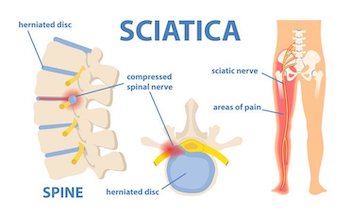Has your doctor ever said you have Sciatica? Sciatica, or Lumbar Radiculopathy, refers to pain that follows the sciatic nerve as the nerve roots leave your back/lumbar spine and enters your leg. This could include pain in your buttocks, back of leg, calf, or even symptoms into your feet. Most of the time, Sciatica will decrease after non-operative treatment.
- Symptoms of Sciatica include: Numbness, tingling, burning, electrical shock, a mild ache or muscle weakness.
- Causes of Sciatica include: Bone spurs, a herniated disc, tight muscles (piriformis especially) or narrowing of the spine (stenosis).
All of these can compress on the nerve/spinal cord causing irritation to the nerve.
Three of the main causes of sciatica are a herniated disc or spinal stenosis.
Herniated discs can form due to a person lifting an object improperly in typically a forward bent position while twisting. This causes the disc to bulge backwards and to the side where it can press on a nerve, or it may cause irritation near the nerve creating sciatic symptoms (see above).
Stenosis is a narrowing of the spinal canal or the intervertebral foramen. This could be due to osteoarthritis or if your body decides to lay extra bone along your nerve/Spinal Cord based on overuse in that area. This can lead to sciatic symptoms (see above).
The piriformis muscle travels over top of your sciatic nerve. If this muscle starts to lose its flexibility or begins to spasm, it could press on the sciatic nerve. Multiple items can lead to this from a sedentary lifestyle, lifting objects improperly, or if one begins to favor one side of their body based on a previous injury.
Physical therapy helps reduce Sciatica with:
- Hands-on techniques
- Therapeutic exercise customized to your pain
- Education
There are two simple ways to perform a sciatic nerve glide:
- Seated: Sit in a chair with your back supported in an upright position. Straighten your leg with your sciatic symptoms with your toes pointing forward like a ballerina. Once your leg is straight, pull your foot up so your toes are pointing up toward the ceiling. You should feel a pull down the back of your leg. Hold for 1 second. Next, point your foot forward again and bring your foot back to the ground. Repeat 2 sets x 10 reps.
- Laying on your back: Place your hands behind the knee with the sciatic symptoms. Bring your knee up so it is perpendicular with your body with your knee bent. Slowly straighten your leg with your toes pointed forward like a ballerina. Once your leg is as straight as it can go, pull your foot up out of the pointed position. You will feel an increase in pull in your leg. Hold for 1 second. Point your foot forward again and slowly lower your leg. Repeat 2 sets x 10 reps.
A Piriformis Stretch can also help:
- Seated: Sitting in a chair with back support, cross your leg with sciatic symptoms and place your foot on the opposite knee. Put your hands around your knee and pull your knee towards your opposite shoulder until you feel a stretch in your buttocks. Hold for 30 seconds. Repeat 3 sets x 30 second hold.
- Laying on your back: Start with your knee bent on the leg that has sciatic symptoms. Place your hand on the front of your knee and pull your leg up and towards your opposite shoulder. You should feel a pull in your buttocks. Hold for 30 seconds. Repeat 3 sets x 30 second hold.
Sciatica – Symptoms and causes – Mayo Clinic
Lumbar Spinal Stenosis | Johns Hopkins Medicine
Herniated disk – Symptoms and causes – Mayo Clinic
Innovative Physical Therapy, “Solutions in Motion”
619-260-0750
